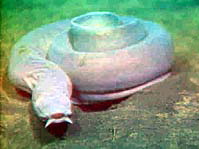Hagfish absorb food directly through its skin

Hagfish
Hagfish, an elongated scavenger found on the bottom of the sea, is truly a weird and wonderful creature. A single fossil of hagfish shows that is has undergone little evolutionary change in the last 300 million years, and the hagfish is believed to the be oldest living connection to the first vertebrate. Its the Hagfish, an elongated scavenger found on the bottom of the sea, is truly a weird and wonderful creature. A single fossil of hagfish shows that is has undergone little evolutionary change in the last 300 million years, and the hagfish is believed to the be oldest living connection to the first vertebrate. Its eyespots can detect light but lacks both lens and extrinsic musculature, and is therefore believed to show a significant step in the evolution of more complex eyes. The hagfish is also famous for exuding vast amounts of a gel-like slime when threatened. An adult hagfish can secrete enough slime to turn a 20 litre (5 gallon) bucket of water into slime in a matter of minutes. When captured, e.g. by a human or predatory fish, it will tie itself in an overhand knot which gradually works its way from the head to the tail of the hagfish, scraping off the slime as it goes, thus freeing the hagfish from its captor and from the slime in one swift movement.
Hagfish eat dead and injured sea creatures and will borrow into the body cavity of a dead (or dying!) animal to devour it from within. Once its full, it can go several months without feeding again.
Now, a new study on hagfish caught near Vancouver Island in Canada has unveiled yet another remarkable fact about the hagfish – it seems as though this fish is actually able to eat with its skin and gills, i.e. absorb nutrients through its skin and gills instead of using its mouth.
A research team* headed by Chris Glover of the University of Canterbury in New Zealand and Bamfield Marine Sciences Center took skin and gill tissue from hagfish and tested the tissues’ absorption of two different amino acids.
“We wanted to start with a simple dissolved organic nutrient, and given the fact that the food source is a large decaying pile of protein, an amino acid seemed to be the best place to start,” says Glover.
When a hagfish has managed to burrow its way into a carcass, it will feed surrounded by a high concentration of dissolved nutrients, so being able to absorb food through more than just its mouth could come in handy.
The results of the study carried out by Glover and his colleges indicate that specific molecular mechanisms exist within the hagfish tissues to move the two tested amino acids into the body of the fish. When researchers increased the concentration of amino acids the tissue increased its absorption – but only up to a certain level.
“A quick and simple calculation suggests that the skin in particular may be capable of absorbing nutrients at levels equivalent to that of the digestive tract!”, says Glover.
There are quite a few invertebrates, including many mollusks and worms, that can absorb nutrients through their skin. But up until now, no vertebrates have been known to have this capacity. The hagfish may represent a transition between the feeding habits of aquatic invertebrates like mollusks and the more specialized digestive systems found in vertebrates. While some organisms exchange nutrients with the water around them in order to maintain their body fluid salt concentrations, the hagfish is – according to Glover – likely to transport amino acid molecules through its skin and gills exclusively to feed itself.
The paper “Adaptations to in situ feeding: novel nutrient acquisition pathways in an ancient vertebrate” has been published in the most recent issue of journal Proceedings of the Royal Society B: Biological Sciences.
* Chris N. Glover (http://www.biol.canterbury.ac.nz/people/glover.shtml) School of Biological Sciences, University of Canterbury, Christchurch, New Zealand Bamfield Marine Sciences Centre, Bamfield, British Columbia, Canada
Carol Bucking (no bio page available) Bamfield Marine Sciences Centre, Bamfield, British Columbia, Canada Department of Zoology, University of British Columbia, British Columbia, Canada
Chris M. Wood (http://www.biology.mcmaster.ca/faculty/wood/wood.htm) Bamfield Marine Sciences Centre, Bamfield, British Columbia, Canada Department of Biology, McMaster University, Ontario, Canada